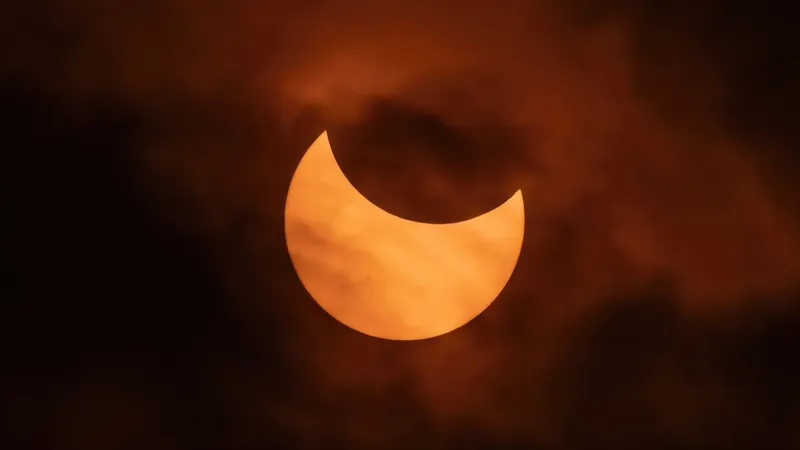
Get Ready for the Spectacular March 29 Solar Eclipse – Here's Where You Can See It!
2025-03-24
Author: Jessica Wong
Get your eclipse glasses ready! On Saturday, March 29, a captivating astronomical event will unfold as a partial solar eclipse graces the northeastern coast of North America. As the sun rises, observers will witness a majestic crescent-shaped sun peeking over the horizon.
Where to Catch the Best Views of the Eclipse
Thirteen U.S. states will have the chance to experience varying degrees of this celestial phenomenon. If you’re located in coastal New England, you’re in for the treat of a lifetime! Maine will experience the most dramatic effect, with up to 86% of the sun obscured at sunrise. Neighboring states will not be left out either—New Hampshire and Massachusetts will see up to 57% and 55% coverage, respectively, while Boston will witness a 43% eclipse.
However, the excitement doesn't end there! The eclipse will be less pronounced further south. New York City will enjoy a modest 21% obscuration, and the visibility drops significantly in Philadelphia (11%), Rochester (8%), and Washington, D.C. (a mere 1.2%). Those looking to catch a glimpse should prioritize coastal spots situated further north for the best views.
Safety First!
Remember, this is a partial eclipse, so it is crucial to use protective eyewear, such as certified solar eclipse glasses or a properly filtered telescope, to avoid damaging your eyes. Clear sightlines to the east-northeast are essential for optimal viewing, so consider using tools like Time and Date's eclipse map or The Photographer's Ephemeris app to scout out the perfect viewing locations.
Witness the Rare 'Double Sunrise'
As if the partial eclipse wasn’t enough to get your heart racing, a rare "double sunrise" will be observable from select regions! This extraordinary phenomenon occurs when the silhouette of the moon creates an illusion of two sunrises with “horns” emerging from the horizon. This visual delight can be seen primarily in northeastern Maine, southwestern New Brunswick, and eastern Quebec. Ideal spots such as Quoddy Head State Park, South Lubec in Maine, Forestville in Quebec, and St. Andrews in New Brunswick will offer a view of an 83% to 87% eclipsed double sunrise.
In Atlantic Canada, the eclipse will have a slightly muted effect. Moncton, New Brunswick, will see an eclipse covering about 84%, while Halifax, Nova Scotia, reports 82%. Quebec City will experience a 72% obscuration, with Montreal and Ottawa observing 46% and 29%, respectively. Unfortunately, Toronto will be out of luck this time, as no eclipse will be visible from that location. The peak of this eclipse is expected to be near Akulivik, Nunavik, where up to 91% of the sun will be obscured!
Global Eclipse Insights: What About Europe and Africa?
If you’re outside North America, don’t fret—this solar spectacle will also reach parts of Europe and Africa, although at a later time. Reykjavik, Iceland, will see a 67% obscuration, but if you’re in cities like London (31%), Paris (24%), Madrid (20%), Berlin (15%), Vienna (6%), or Rome (2%), the eclipse will be less impressive. Coastal areas in Morocco will see around 15% to 18% of the sun obscured as well.
Mark your calendars, because the next solar eclipse—another partial one—will occur on September 21, 2025, with views available from Antarctica, New Zealand, and parts of the southwestern South Pacific. Following that, a significant total solar eclipse will sweep across Europe and other regions on August 12, 2026.
So get your planning started because this March 29 solar eclipse promises to be an unforgettable event—don’t miss out!

 Brasil (PT)
Brasil (PT)
 Canada (EN)
Canada (EN)
 Chile (ES)
Chile (ES)
 Česko (CS)
Česko (CS)
 대한민국 (KO)
대한민국 (KO)
 España (ES)
España (ES)
 France (FR)
France (FR)
 Hong Kong (EN)
Hong Kong (EN)
 Italia (IT)
Italia (IT)
 日本 (JA)
日本 (JA)
 Magyarország (HU)
Magyarország (HU)
 Norge (NO)
Norge (NO)
 Polska (PL)
Polska (PL)
 Schweiz (DE)
Schweiz (DE)
 Singapore (EN)
Singapore (EN)
 Sverige (SV)
Sverige (SV)
 Suomi (FI)
Suomi (FI)
 Türkiye (TR)
Türkiye (TR)
 الإمارات العربية المتحدة (AR)
الإمارات العربية المتحدة (AR)